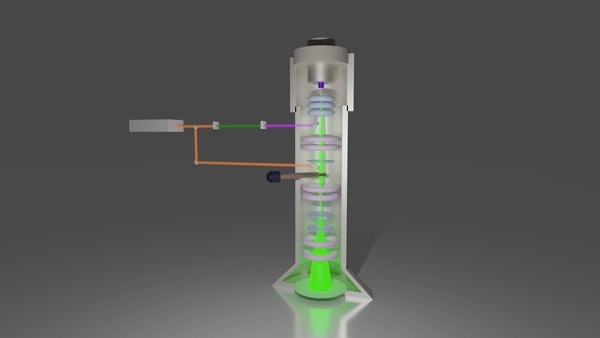Three physicists from RIKEN have illustrated the ability of an ultrafast form of transmission electron microscopy to quantify sound waves in nanostructures.

A cutaway of the ultrafast transmission electron microscope (UTEM) that RIKEN researchers used to image ultrahigh-frequency sound waves in a thin silicon plate. The laser one the left provides two beams, one (upper beam) that interacts with the electron beam (green) of the microscope and the other (lower beam) illuminates the sample. Image Credit: © 2023 RIKEN Center for Emergent Matter Science
This can help identify a high-resolution imaging technique that makes use of ultrahigh-frequency sound waves to image structures that are nanometers in size.
Ultrasound is regularly utilized in clinics and hospitals to image internal organs and babies in the womb. Generally, the sound waves used are a few millimeters in wavelength, so they could image structures down to that level.
While such a resolution is considered to be fine for medical imaging, physicists would like to utilize sound waves to image structures in materials that measure around a few nanometers.
If we can use sound waves that have wavelengths of about 100 nanometers or so, we can use them for inspecting materials, such as finding defects. But the sensitivity to small defects really depends on the wavelength.
Asuka Nakamura, Center for Emergent Matter Science, RIKEN
This needs generating and detecting sound waves that consist of much smaller wavelengths (and thus higher frequencies). Making such high-frequency sound waves is comparatively simple—ultrashort laser pulses have been utilized to produce them in metals and semiconductors for many decades.
However, detecting them is highly difficult as it needs developing detectors that have the potential to obtain a resolution of nanometers in space and picoseconds in time.
At present, Nakamura, together with CEM collaborators Takahiro Shimojima and Kyoko Ishizaka, have illustrated the ability of a unique kind of electron microscope for imaging such ultrahigh-frequency sound waves.
Particularly, they utilized an ultrafast transmission electron microscope (UTEM) to detect sound waves produced by a 200-nm hole in the center of an ultrathin silicon plate. A UTEM makes use of two laser beams with a slight delay between them.
One beam is responsible for illuminating the sample, while the other produces an ultrashort pulse of electrons in the microscope. This setup allows very short timescales to be resolved.
Theoretically, when the trio simulated the waves and made a comparison of the simulations with experimentally achieved images, they discovered good agreement.
The quality of the images surpassed the team’s expectations, thereby enabling them to execute Fourier-transform analysis—a commonly utilized mathematical analytic method—on the images.
Before performing these experiments, we didn’t intend to characterize the sound waves. But after taking the data, we noticed they were very beautiful, and we could apply Fourier transformation. That was surprising for me.
Asuka Nakamura, Center for Emergent Matter Science, RIKEN
Currently, the scientists mean to analyze ultrafast magnetic and structural dynamics in solids induced by such nanometric sound waves utilizing UTEM.
Journal Reference
Nakamura, A., et al. (2023) Characterizing an Optically Induced Sub-micrometer Gigahertz Acoustic Wave in a Silicon Thin Plate. Nano Letters. doi.org/10.1021/acs.nanolett.2c03938.